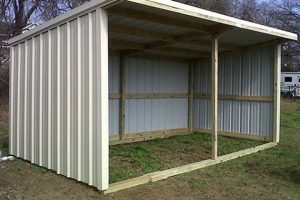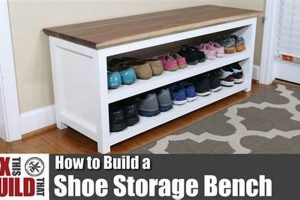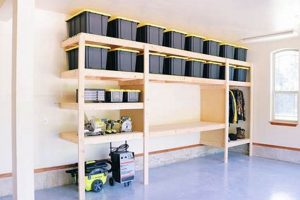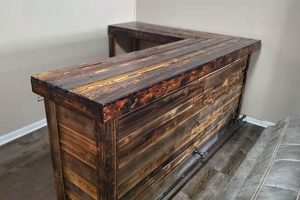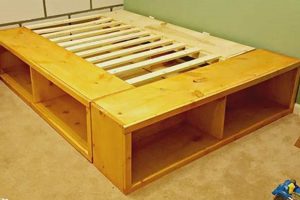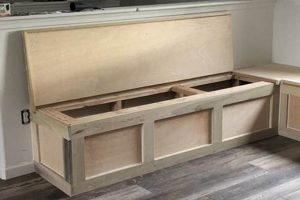A self-assembled sleeping platform incorporating drawers, compartments, or an elevated structure to provide space for stowing personal belongings represents a practical solution for maximizing room organization. This type of furniture construction often involves utilizing readily available lumber, hardware, and basic carpentry skills to create a customized and functional piece.
The advantages of such a project extend beyond mere space conservation. Constructing furniture offers significant cost savings compared to purchasing pre-made alternatives. Further, it allows for precise dimensional adjustments to fit unique room layouts and specific storage requirements. Historically, utilizing the area beneath a bed for storage has been a common practice, evolving from simple boxes to integrated and aesthetically pleasing designs.
The following sections will detail crucial considerations for planning and executing a successful construction, including material selection, design approaches, and essential building techniques for a robust and aesthetically pleasing outcome.
Construction Guidance
The following guidelines aim to provide essential information for planning and executing a successful build. Careful consideration of these points will enhance the final product’s durability, functionality, and aesthetic appeal.
Tip 1: Material Selection: Choose lumber based on desired aesthetics, structural requirements, and budget. Solid hardwoods offer superior strength and longevity, while softwood options, like pine, are more economical but may require additional reinforcement. Consider the use of plywood or MDF for drawer boxes and other non-structural components.
Tip 2: Design Planning: Prioritize accurate measurements of the mattress and available room space. A detailed blueprint, including dimensions of all components and joinery methods, is crucial for minimizing errors during construction. Account for accessibility to storage compartments and the overall height to ensure comfortable use.
Tip 3: Foundation Strength: The support structure must be robust enough to withstand the combined weight of the mattress, bedding, and occupants. Reinforce corners with metal brackets, and consider adding center supports for larger frames to prevent sagging. Evaluate weight distribution and use appropriate leg placement.
Tip 4: Joinery Techniques: Select appropriate joinery methods based on skill level and the intended load-bearing capacity. Dovetail joints and mortise-and-tenon joints offer exceptional strength, while simpler methods, such as screwing and gluing, can be effective with proper reinforcement. Ensure precise cuts and tight fitting connections.
Tip 5: Hardware Selection: Utilize high-quality hardware for drawers, hinges, and support mechanisms. Drawer slides should be rated for the intended weight load, and hinges should be durable enough to withstand repeated use. Consider soft-close mechanisms for added convenience and noise reduction.
Tip 6: Finishing and Aesthetics: Apply a protective finish to enhance the wood’s durability and resistance to moisture. Sand all surfaces smooth before applying stain, paint, or sealant. Consider the overall design aesthetic and choose a finish that complements the room’s decor.
Tip 7: Safety Considerations: Prioritize safety throughout the construction process. Wear appropriate safety gear, including eye protection and a dust mask. Ensure a well-ventilated workspace, and follow all manufacturer’s instructions for power tools and adhesives. Secure the finished product to the wall if necessary to prevent tipping.
By adhering to these guidelines, individuals can create a functional and aesthetically pleasing platform that maximizes storage space while enhancing the overall organization of a bedroom. Careful planning, precise execution, and attention to detail are paramount to achieving a successful result.
The next segment will address potential challenges encountered during the assembly process and offer troubleshooting strategies for common issues.
1. Material Strength
Material strength is a paramount consideration in the design and construction of a self-assembled sleeping platform with integrated storage. The structural integrity and longevity of the resulting furniture piece depend directly on the load-bearing capacity and resistance to deformation of the chosen materials.
- Load-Bearing Capacity of Frame Lumber
The selection of lumber for the primary frame directly dictates the maximum weight it can safely support. Hardwoods such as oak or maple offer significantly greater compressive strength and resistance to bending compared to softwoods like pine. The choice hinges on the expected weight of the mattress, bedding, and occupants. Insufficient strength leads to sagging, instability, and potential structural failure.
- Impact Resistance of Drawer Components
Drawer boxes and faces must withstand repeated use and potential impacts. Plywood, with its multi-layered construction, exhibits greater resistance to splitting and warping than solid wood of comparable thickness. MDF (Medium-Density Fiberboard) provides a smooth surface for finishing but is more susceptible to damage from moisture and impacts, making it less suitable for high-stress areas.
- Fastener Strength and Joint Integrity
The strength of the fasteners (screws, bolts, nails) used to assemble the structure contributes significantly to its overall stability. Properly sized and spaced fasteners, combined with appropriate joinery techniques (dovetails, mortise and tenon), distribute weight and resist shear forces. Undersized or poorly placed fasteners compromise joint integrity and reduce the overall load-bearing capacity.
- Resistance to Creep and Deformation
Over time, materials subjected to sustained loads can exhibit creep (slow deformation under constant stress). Selecting materials with high elastic modulus and low creep coefficients is essential for maintaining the structural integrity of the platform. Using materials known for their dimensional stability, such as kiln-dried lumber, minimizes the risk of warping or cracking over time.
The interplay of these material properties determines the long-term performance of the storage platform. Careful evaluation of material strength, in relation to the anticipated loads and environmental conditions, is crucial for ensuring a safe, durable, and functional piece of furniture. Proper material selection translates directly into enhanced user safety and increased product lifespan.
2. Design Accuracy
Design accuracy is a foundational element in the successful creation of a self-constructed sleeping platform with integrated storage. Precision in planning and dimensioning directly influences the structural integrity, functional utility, and aesthetic integration of the finished product within a given space.
- Dimensional Precision in Frame Construction
Accurate measurements of the mattress and the intended room footprint are critical for establishing the overall dimensions of the platform. Variances from these initial measurements can lead to insufficient mattress support, wasted space, or incompatibility with the existing room layout. Precise cutting of lumber, based on these dimensions, is essential for a level and stable structure.
- Storage Compartment Sizing and Accessibility
The internal dimensions of drawers, shelves, and other storage compartments must be carefully planned to accommodate intended contents. Inaccurate sizing can render compartments unusable or limit their functionality. Considerations for accessibility, such as drawer slide clearances and door swing radii, are integral to a user-friendly design.
- Joinery and Fastener Placement
Design accuracy extends to the precise placement of joinery elements, such as mortise and tenon joints or screw locations. Misaligned joints or incorrectly positioned fasteners weaken the overall structure and compromise its ability to withstand weight and stress. Detailed blueprints and templates are essential for ensuring accurate joinery.
- Hardware Integration and Functionality
Accurate specifications and placement of hardware components, including drawer slides, hinges, and support legs, are vital for proper functionality. Incorrectly positioned hardware can lead to binding drawers, misaligned doors, or unstable support. Thorough research and accurate measurement of hardware components are necessary for seamless integration into the overall design.
The cumulative effect of dimensional precision, compartment sizing, joinery accuracy, and hardware integration directly impacts the practicality and longevity of the self-constructed sleeping platform. A meticulously planned and executed design, characterized by dimensional accuracy, ensures a structurally sound, functionally efficient, and aesthetically pleasing addition to the living space.
3. Joint Durability
Joint durability represents a critical factor in the structural integrity and lifespan of any self-constructed sleeping platform with integrated storage. The ability of the connecting points within the frame to withstand stress and repeated use directly impacts the stability and long-term functionality of the entire piece of furniture.
- Load-Bearing Capacity of Joint Types
Different joint types exhibit varying levels of resistance to shear and tensile forces. Dovetail joints, for example, provide superior strength in resisting pull-out forces compared to simple butt joints secured with screws. The selection of appropriate joint types, based on anticipated load distribution and stress points within the frame, is paramount for preventing joint failure. A bed frame supporting a heavy mattress and occupant load requires robust joints, particularly at the corners and along the primary support beams.
- Material Compatibility and Adhesive Strength
The effectiveness of adhesive used in conjunction with mechanical fasteners significantly contributes to joint durability. The chosen adhesive must be compatible with the materials being joined (e.g., wood type, finish) and possess sufficient shear strength to withstand sustained stress. Inadequate adhesive selection or application can lead to joint separation and structural weakening over time, especially in areas subjected to high humidity or temperature fluctuations.
- Fastener Selection and Placement
The size, type, and spacing of fasteners (screws, bolts, nails) directly influence joint stability. Overdriving screws or using undersized fasteners weakens the surrounding material and reduces their holding power. Proper fastener placement, ensuring adequate penetration and avoidance of end-grain splitting, is crucial for maximizing joint strength. For heavy-duty applications, through-bolting with washers and locking nuts provides superior resistance to loosening and joint failure compared to screws alone.
- Environmental Factors and Joint Degradation
Exposure to moisture, temperature fluctuations, and insect activity can degrade joint integrity over time. Proper sealing and finishing of the wood surfaces, including the joints themselves, helps protect against moisture penetration and insect infestation. Regular inspection of joints for signs of loosening, cracking, or rot is essential for identifying and addressing potential problems before they compromise the structural integrity of the entire frame. In coastal environments, corrosion-resistant fasteners are crucial for preventing premature joint failure.
The successful construction of a long-lasting sleeping platform with integrated storage relies heavily on meticulous attention to joint durability. Careful consideration of joint type, material compatibility, fastener selection, and environmental factors ensures a stable and robust structure capable of withstanding the rigors of daily use for years to come. Neglecting joint durability compromises the entire project, regardless of the quality of other materials or design elements.
4. Hardware Quality
The longevity and functionality of a self-constructed sleeping platform with integrated storage are directly contingent upon the quality of the hardware employed. Hardware encompasses a broad range of components, including drawer slides, hinges, fasteners, and support elements. Inferior hardware inevitably leads to premature failure, compromising the structural integrity and usability of the frame. A drawer slide with a low weight rating, for instance, may buckle under the load of a fully packed drawer, rendering the storage space inaccessible. Similarly, hinges constructed from weak metal alloys are prone to breakage, leading to misalignment and functional impairment of doors or access panels. The initial cost savings associated with low-grade hardware are invariably offset by the expense and labor required for replacement and repair.
Practical applications of high-quality hardware are readily apparent. Soft-close drawer slides, manufactured from durable steel and incorporating precision bearings, provide smooth and silent operation, enhancing user experience and preventing damage to drawer components. Heavy-duty bed frame brackets, constructed from thick-gauge steel, ensure a stable and secure connection between the frame components, preventing wobbling and potential collapse. Similarly, high-quality fasteners, such as hardened steel screws and bolts, provide superior holding power and resistance to corrosion, ensuring the long-term structural integrity of the frame. Selection of hardware should align with the intended use and load-bearing requirements of each specific component. Furthermore, investing in hardware from reputable manufacturers, known for their quality control and adherence to industry standards, is a prudent measure to mitigate the risk of premature failure.
In summary, the selection of high-quality hardware is an indispensable aspect of constructing a durable and functional sleeping platform with integrated storage. The initial investment in robust and reliable components translates into long-term cost savings by minimizing the need for repairs and replacements. Neglecting hardware quality undermines the overall integrity of the project, potentially leading to safety hazards and diminished usability. Prioritizing hardware quality is, therefore, essential for achieving a successful and enduring outcome.
5. Space Optimization
The impetus behind constructing a sleeping platform with integrated storage often stems from a need for amplified living space within a constrained environment. Space optimization, therefore, becomes a cardinal design parameter. The absence of this consideration transforms what could be a functional enhancement into a bulky impediment. For instance, a narrow bedroom in an urban apartment benefits considerably from a raised platform concealing multiple drawers and shelves, effectively eliminating the need for a separate dresser and freeing up valuable floor area. Conversely, a poorly designed platform, excessively large and lacking efficient internal compartmentalization, defeats the purpose by occupying a disproportionate amount of space and providing inadequate storage relative to its footprint.
The correlation between these elements is multifaceted. The initial assessment of available square footage dictates the platform’s maximum dimensions. Subsequently, the internal design must prioritize efficient allocation of storage volume. This necessitates careful consideration of the types of items to be stored, ranging from bulky bedding to smaller personal effects, and the implementation of appropriately sized and configured compartments. Ineffective planning can result in wasted space within the platform, negating its primary advantage. Real-world application involves meticulous measurement and the creation of scaled drawings to visualize the final product and assess its impact on the room’s overall flow and functionality. Failure to account for these factors leads to a suboptimal utilization of space, rendering the construction effort less effective.
In conclusion, the successful integration hinges on a holistic approach to design. The sleeping platform cannot exist solely as a storage container; it must seamlessly blend with the existing environment, enhancing both functionality and aesthetics. Challenges arise in balancing storage capacity with accessibility and minimizing the platform’s visual impact. Achieving optimal space utilization necessitates careful planning, precise execution, and a thorough understanding of the symbiotic relationship between the structure and its surroundings. The practical significance lies in transforming a confined living area into a more organized and comfortable space, thereby improving the overall quality of life within that environment.
6. Weight Distribution
In the context of a self-constructed sleeping platform with integrated storage, weight distribution emerges as a crucial element directly impacting structural integrity and long-term stability. Uneven weight distribution initiates a cascade of potential problems, ranging from localized stress concentrations that lead to premature material fatigue to catastrophic structural failure, jeopardizing safety and negating the intended utility of the unit. A prime example involves a scenario where storage compartments are concentrated on one side of the frame without adequate counterbalancing support on the opposite side. The resulting asymmetrical loading induces a twisting force, straining the frame’s joints and potentially causing warping or collapse. Accurate weight distribution is not merely an aesthetic consideration; it is a fundamental engineering principle that governs the safety and durability of the entire structure.
Practical application of weight distribution principles necessitates a comprehensive understanding of the platform’s load-bearing capacity and the anticipated weight of its contents. This involves calculating the weight of the mattress, bedding, occupants, and stored items, then strategically positioning support elements to evenly distribute this load across the frame. Techniques include incorporating center support beams for larger platforms, employing multiple support legs with even spacing, and utilizing internal structural members to transfer weight from loaded compartments to the supporting framework. Failure to implement these measures can lead to localized stress points, causing joints to loosen, surfaces to sag, and the overall structure to become unstable. The practical significance of this understanding translates to a safer, more reliable, and longer-lasting sleeping platform.
Ultimately, attention to weight distribution represents an investment in the longevity and safety of the self-constructed sleeping platform with integrated storage. Challenges arise in accurately predicting load distribution under varying use conditions and implementing structural reinforcements that do not compromise accessibility or aesthetic appeal. Overcoming these challenges requires careful planning, precise execution, and a thorough understanding of basic structural principles. The broader theme underscores the importance of considering engineering fundamentals in design, ensuring that functionality and aesthetics are not achieved at the expense of structural integrity and user safety.
Frequently Asked Questions
The following section addresses prevalent inquiries concerning the design and construction of self-assembled sleeping platforms incorporating storage features. The responses aim to provide clarity and guidance on key aspects of the building process.
Question 1: What lumber species offers the optimal balance of cost-effectiveness and structural integrity for the frame?
For the primary frame, kiln-dried pine represents a balance between affordability and adequate strength for smaller platforms. However, for larger frames intended to support significant weight, hardwoods such as poplar or oak are recommended to ensure structural stability and longevity.
Question 2: What joinery methods are most suitable for securing the corners of the platform frame?
Mortise and tenon joints, secured with adhesive and mechanical fasteners, provide exceptional strength and resistance to racking forces. Alternatively, corner brackets fabricated from heavy-gauge steel can be used to reinforce butt joints, offering a simpler but less aesthetically refined solution.
Question 3: What is the recommended weight rating for drawer slides used in the storage compartments?
Drawer slides should be selected based on the anticipated weight of the stored contents. As a general guideline, slides rated for at least 75 pounds are recommended for standard drawers, while heavier-duty slides with a rating of 100 pounds or more should be used for larger drawers intended to hold heavier items.
Question 4: What is the optimal height for the platform, considering both storage capacity and ease of access?
The optimal height is contingent upon individual preferences and spatial constraints. However, a height of 18 to 24 inches generally provides sufficient storage volume while maintaining comfortable accessibility for most individuals. Consider the mattress thickness when determining the final platform height.
Question 5: How should the storage compartments be configured to maximize usable space and organization?
Compartment configuration should be tailored to the specific items intended for storage. Dividers, shelves, and pull-out trays can enhance organization and accessibility. Vertical dividers are effective for storing books or linens, while shallow drawers are ideal for smaller items.
Question 6: What type of finish is recommended to protect the wood from moisture and wear?
A durable polyurethane finish provides excellent protection against moisture, scratches, and stains. Multiple coats are recommended, with light sanding between coats to ensure a smooth and even surface. Alternatively, a penetrating oil finish can enhance the natural beauty of the wood while providing adequate protection.
These responses represent general guidelines and should be adapted based on individual project requirements and skill level. Prioritizing safety and structural integrity is paramount throughout the design and construction process.
The subsequent section will delve into troubleshooting common problems encountered during the assembly process and provide strategies for addressing potential issues.
Conclusion
The preceding exploration of the self-assembled sleeping platform integrating storage highlights the multifaceted considerations essential for a successful endeavor. Structural integrity, material selection, design accuracy, and hardware quality represent critical determinants of the finished product’s utility and longevity. Attention to these details ensures a durable and functional addition to the living space.
The decision to pursue a self-directed project necessitates a commitment to careful planning and precise execution. By adhering to sound construction principles and prioritizing safety, the resulting structure can provide enhanced storage capacity and contribute to improved space optimization. The successful realization of this project depends on a meticulous approach to design and construction.


